The sea is like liquid glass. Nothing ripples the surface. We are drifting on a deep blue ocean in complete calm. The sails are secured so that they don’t flap back and forth in the long Atlantic swell. We drift during the day. After sunset, we start the engine so that the batteries don’t drain completely when the solar panels stop feeding them.
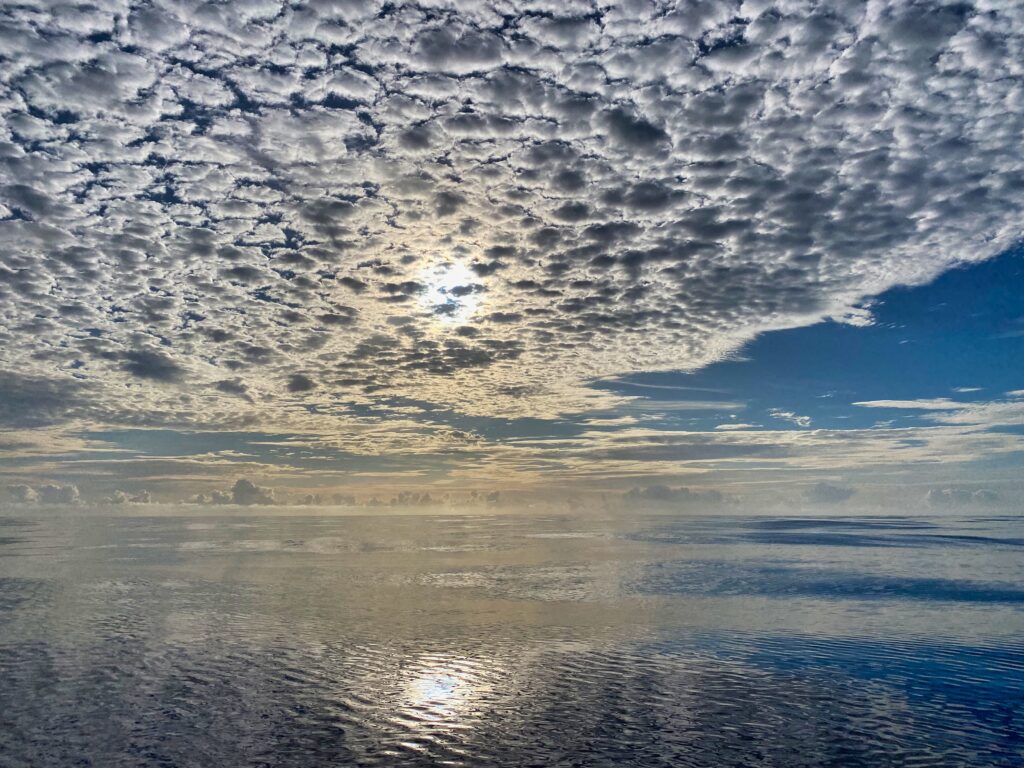
In the doldrums
It is Saturday 18 May 2024 and we are pretty much halfway between Bermuda and the Azores. It’s the 14th day at sea since we left Jolly Harbour in Antigua.
Solo sailing routine
We means my German-Indonesian companion Davi and me. We’ve been together since February, when we left Mindelo in Cape Verde, and we’re now a well-rehearsed team. The few manoeuvres – setting sails, reefing, furling and unfurling the genoa – work perfectly. We don’t have a watch system. I stick to my solo sailing routine and rarely sleep for more than two hours at a time during the night. Fortunately, Davi is an early riser. By five o’clock at the latest, I can lie down for longer periods – unless a freighter crosses our course, the wind picks up or the batteries are so deeply discharged that the engine has to be started.
The solo sailing routine means getting up regularly, taking a quick look at the plotter and sticking my head out of the companionway. But it’s not unusual for me to climb into the cockpit and look up at the starry sky. The nights are mild and often clear. The view of the sky is – as always at sea – breathtaking. I can’t get enough of it. Just like the sunsets. One is different than the other and the spectacle of colours is intoxicating. Night after night, a spectacle all to ourselves. That’s how it seems to us. We feel safe on our little boat in this huge ocean.
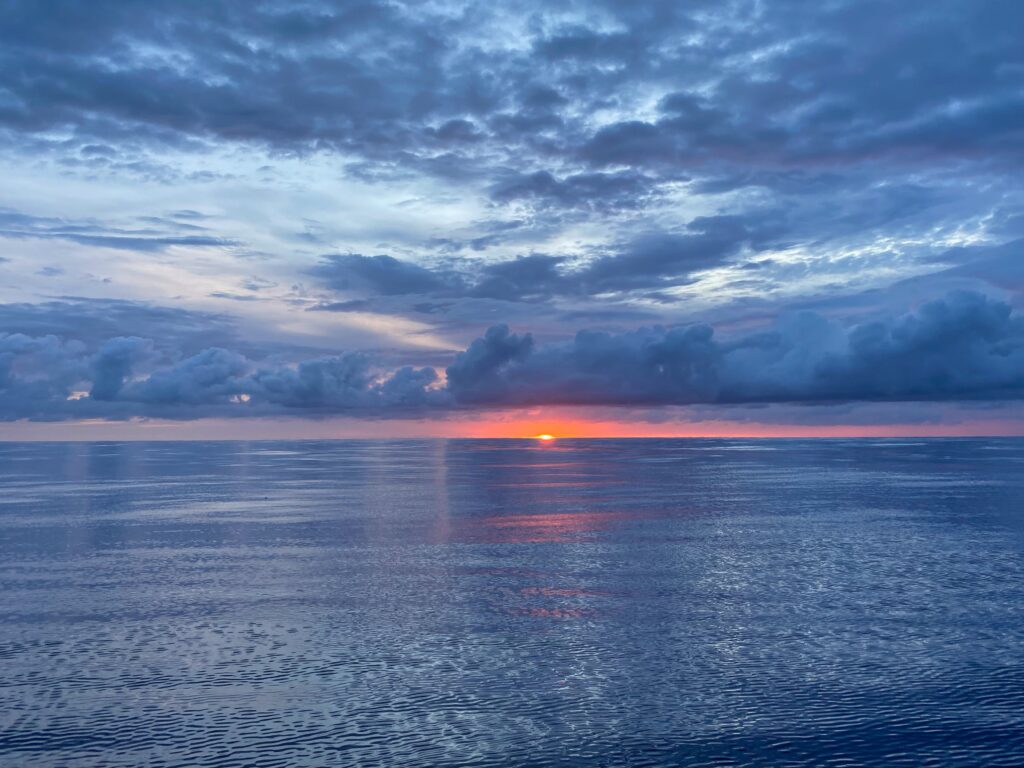
Sunset
The worries and concerns that were still driving me around in the harbour are blown away. The boat seems to be able to cope with any situation. And, more importantly, it runs smoothly and as if on rails, even in rough seas. I have been sailing Blue Alligator for over 20 years. But on this trip across the Atlantic, I got to know her once again from a different angle, as a reliable yacht with the most excellent offshore characteristics.
In Jolly Harbour, when I had to replace the ball bearings in the steering column, the mechanic asked me if I wanted to sell the boat when I got back to Europe. Never in my life. Hopefully we will remain loyal to each other for a long time to come.
Trouble with the batteries
But of course not everything goes smoothly. The batteries were already causing trouble in the Caribbean. They are no longer able to maintain the voltage for long periods of time, even when no consumers are connected. The flexible solar panel that I bought in Martinique and neatly attached to the bimini with Velcro strips gave up the ghost shortly after Antigua. But it took me a while to identify the problem. First, I thought the charger was the culprit. I just couldn’t believe the panel gave. Eventually I replaced it with a foldable panel I had as a reserve. And: problem solfed.
As long as we’re sailing, it’s no big deal anyway. Then the hydrogenerator charges the batteries. It’s reliable, but loud. But as long as it hums, all is well with the world. If it goes silent, seaweed has blocked the propeller. This happens regularly because the Sargasso grass floats in huge carpets on the surface and it is impossible to avoid them. We often have to stop the boat twice a day, lift the generator out of the water and pull the grass, which is as tough as string, off the propeller
Are the diesel reserves sufficient?
Of course, the generator doesn’t run in calm conditions. So we decide to run the engine at night. But I don’t dare to motor for 24 hours. I don’t know whether the diesel reserves are sufficient. The tank holds 95 litres. Six 20-litre jerrycans are lashed to the deck. The iron reserve rests in a locker: a 10-litre canister. That will have to do.
But the doldrums only lasts three days. Suddenly the wind is back. I keep expecting it to blow hesitantly at first and then gain strength. But it happens very quickly. As if someone had opened a ventilation flap and let the wind in. It’s blowing 15 knots and our world is a different place again. The sails are set and the ship rushes through the sea.
A large depression is passing north of us. It’s textbook: first south-westerly, then westerly, then north-westerly winds. And rain. But nothing bad. No squalls like the ones that hit us just a few days after we had left Antigua.
Squalls
We had only been at sea for two days when black walls of clouds rolled in. The wind suddenly picked up, and when the squalls swallowed us up, it rained like I’d never experienced before. „It’s hailing,“ I said to my companion. But it was just rain. However, the drops were as thick as grapes and as I stood at the wheel, I had to turn my face away because they were hitting me in the face like bullets. The rain fell with such force that it flattened the waves, so that we experienced almost calm seas in 30 knots of wind.
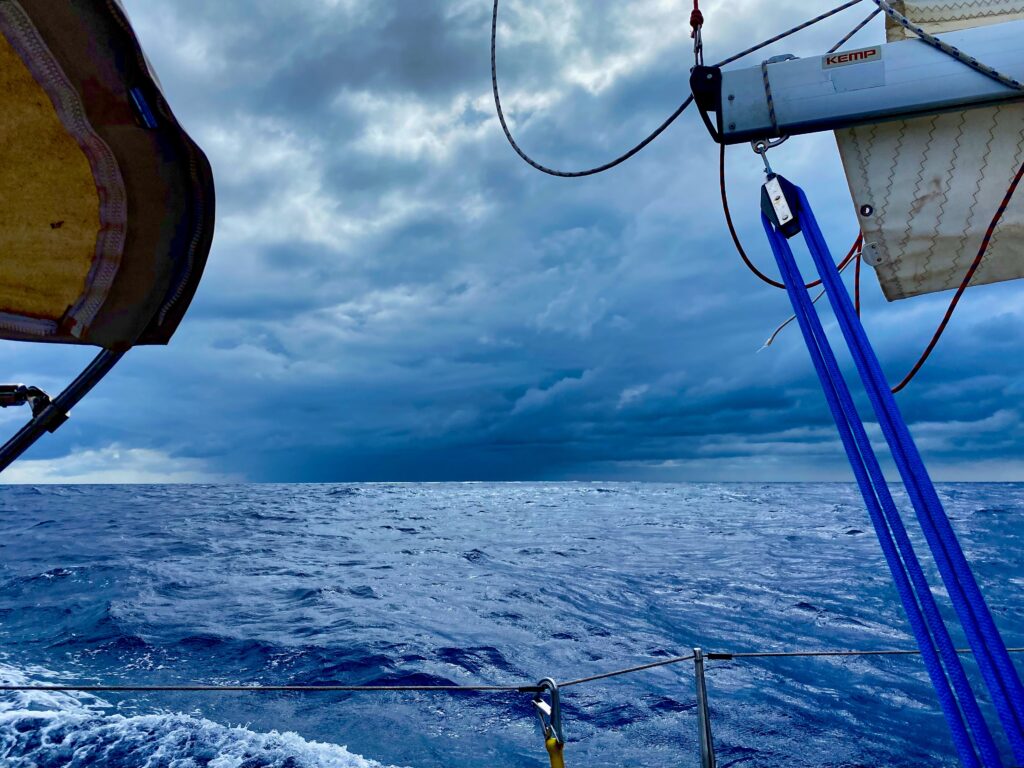
A squall is coming.
The squall lasted maybe half an hour. Then the magic was over. The wind dropped abruptly, shifted slightly and we were sailing over a sea of whitecaps again. During the night, thunderstorms passed by, sometimes so close that lightning was immediately followed by thunder. There are few things I really fear at sea. But thunderstorms are definitely one of them.
I see the lightning strike the sea and know that it’s pure chance whether it hits Blue Alligator or not. When a thunderstorm rolls in, the sailor is at the mercy of fate. But we were lucky, they never came over us and we worried for nothing.
It gets cooler
The closer we get to the Azores, the cooler the Atlantic becomes. From almost 30 degrees in the Caribbean, the temperature soon drops to just over 20 degrees. But the ocean becomes livelier again. Dolphins cross our course and play in the bow wave for a while until they lose interest. One day I see a mighty dorsal fin two or three hundred metres away and a black back. An orca!
They are not dangerous here, they are not tempted to play with the boat and nibble at the rudder as they do along the coasts of Spain and Portugal. And the animal just ignores us.
During the days in the doldrums, we are sitting in the cockpit chatting when a large whale passes by not five metres from us. I assume it’s a sei whale. Its grey speckled back and small fin give it away. Sei whales can be up to 16 metres long and weigh up to 30 tonnes. Blue Alligator, with its eight tonnes, is a lightweight in comparison.
Our hearts beat faster at these encounters. Finally more than just flying fish. The sea is not completely empty after all, although we also encountered Chinese trawlers in the Caribbean waters, deep-sea fishermen on the hunt for the last shoals.
The third crew member
Now that the wind is back, we are on a fast trip again. I am amazed at how good Blue Alligator performes. Six or even seven knots are not uncommon, even though at least one reef is usually tied into the sails. The wind pilot steers with the reliability of clockwork. I dare not imagine what I would do without it.
The Raymarine wheel pilot would not be able to steer the boat for long periods of time with slightly stronger rudder pressure. We used up three drive belts on the outward journey and one broke shortly after Antigua. This system costs a lot and is only suitable for motoring over short distances. It is a toy with which the manufacturer earns a golden nose.
The Windpilot, this mechanical marvel made of aluminium, only needs one thing to do its job: a well-balanced boat. I can deliver that and am rewarded with carefree hours in the bunk. The windpilot is our third crew member who doesn’t have to eat or sleep.
I have only seen a few boats with a wind steering system in the Caribbean. Instead, I have heard many stories of electronic autopilots that failed, condemning crews to endless hours at the helm. Good for those with a strong crew. But I’ve also came across single-handed sailors who had to hold on to the tiller or wheel until they were exhausted because their steering aid gave up. When they arrived, they immediately ran to the chandler and bought expensive spare parts or even a new electric pilot for the price of a wind steering system that was guaranteed to last longer.
And of course, the wind pilot doesn’t suck on our weak batteries either. I am convinced, it as the most useful device on board.
Little helpers
Shortly after that, I elevate snatch blocks to the ranks of items that I consider indispensable equipment for such a passage. Snatch blocks are pulleys that can be opened so that you can thread in a line without having to untie it first. When we unfurled the genoa with the spinnaker pole, the sheet chafed against the railing. A tackle from the mast with a snatch block provided a remedy.
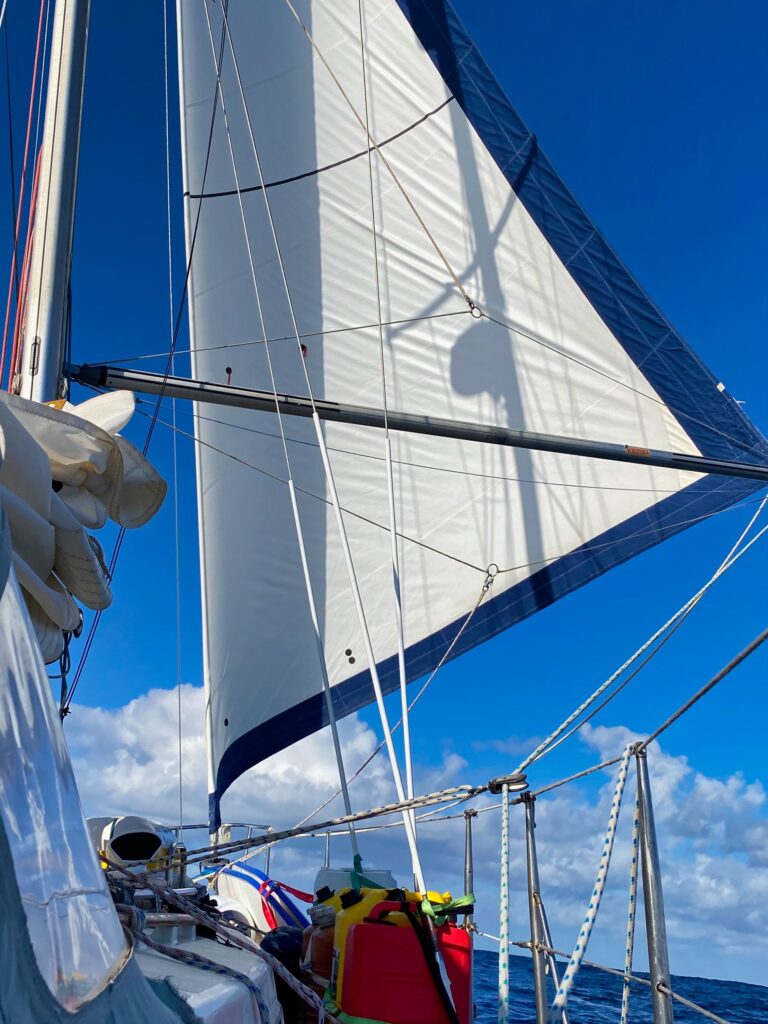
Boomed out genua and a tackle with a snatch block.
While on the outward journey to the Caribbean the U-bolt of the front lower shroud broke, we were spared any more serious damage on the return journey. The only problems were chafe marks on the lines and a small tear in the sail because there was too much tension on one of the lower mast slides in the first reef.
I adjust the reef settings to prevent the sail from tearing even more and repair the tear provisionally with patches, which I bought plenty in the Carebbean. In the Azores, I’ll stich the spot with a piece of Dacron.
Pico in sight
And the journey won’t take much longer.
On 24 May – the day has started cloudy with rain showers and gusts of wind – a fisherman from Peniche crosses our course. A Portuguese for a change.
There are still 247 miles to Horta. The next day there is barely enough wind to sail and we risk starting the engine. My calculations tell me that the diesel will be enough. But I could be wrong, and arriving in Horta without a reserve would be quite unpleasant. But the next morning we recognise Pico, the huge volcanic cone, the highest mountain in Portugal, the Fujiama of the Azores, in the haze. Our hearts beat faster.

Pico in a distance
The closer we get to the Azores, the more AIS signals appear on the chart plotter. It’s a rendezvous of Atlantic sailors. There are at least seven boats ahead of us. One follows in our wake.
Mickey Mouse on helium
We reach Horta after sunset. Again and again we startle seabirds, Cory’s Shearwaters or cagarros, how they are called here. They swim in front of our bow and fly up in loud protest. Their typical cries are the first welcome home. They sound like Mickey Mouse on helium.
In the outer harbour of Horta, the ships lie close together right up to the end of the pier. It’s not easy to find a spot. We drop anchor between a catamaran and another yacht, far too close for my liking. But the anchor holds and we lie quietly until the next morning.
We have arrived, after 22 days at sea. It is 26 May 2024.
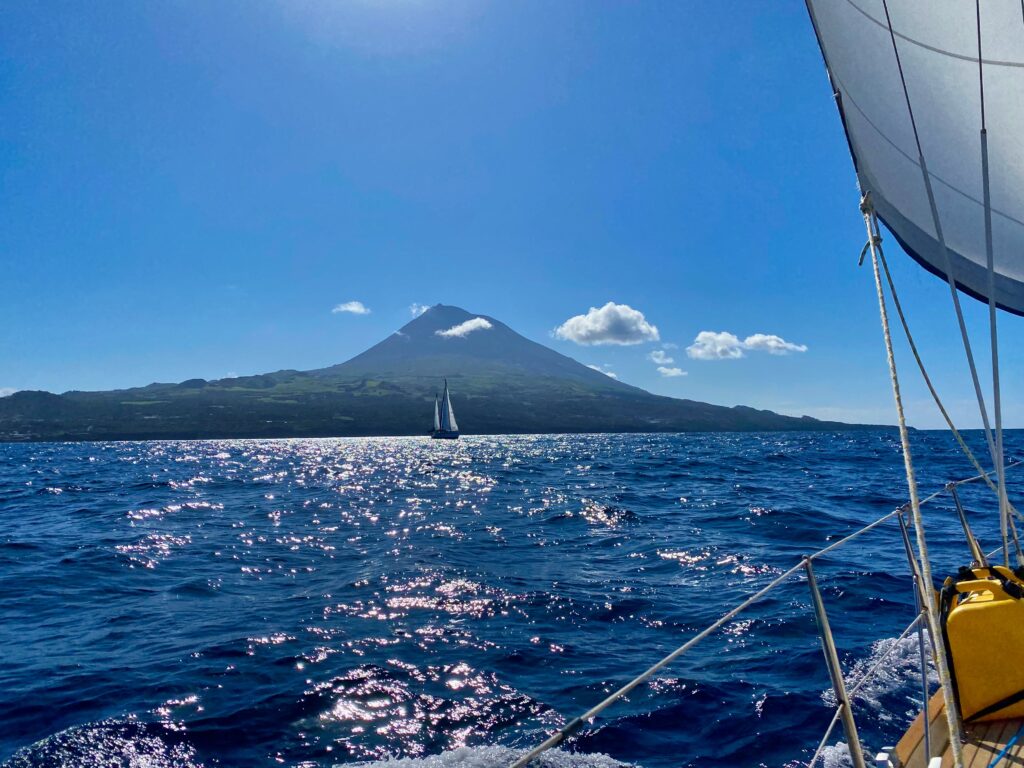
Pico after leaving Horta
The journey is almost over. Davi disembarks in Horta and I set off for Santa Maria four days later. We head south-east with a southerly wind. Huge clouds pile up. Rain and thunderstorms are forcasted. Again and again I see dark bands of cloud passing by, dragging grey curtains of rain with them. I’m lucky. They pass or in front or behind us.
Arrival
When Santa Maria finally comes into view on the afternoon of 31 May, I feel relieved and also infinitely tired. I enter the harbour shortly after 8pm. My berth is free. A friend helps me tie up the lines and invites me for dinner.
I sway and almost fall into the water as I step over the guardrails. After a few glasses of wine, I fall into a deep, dreamless sleep. Blue Alligator tugs a little at her lines. But I think she’s also happy to be back. How long were we travelling? Nine months. We must have done around 7,000 nautical miles – two Atlantic crossings and the trip down to Guinea Bissau – and experienced an infinite number of impressions.
We also got a few scratches, my boat and me. But I guess that’s part of it and a small price to pay for the experience of the Atlantic, where you forget time, where you sometimes feel very small and alone and then again infinitely happy, because everything burdensome falls away from you.
I was absorbed by these hours, days and weeks on a boundless sea, and in the echo of this infinity, it seemed to me, I heard an answer to the question of what life could possibly be about. Maybe I need to listen more closely again. But not right away.
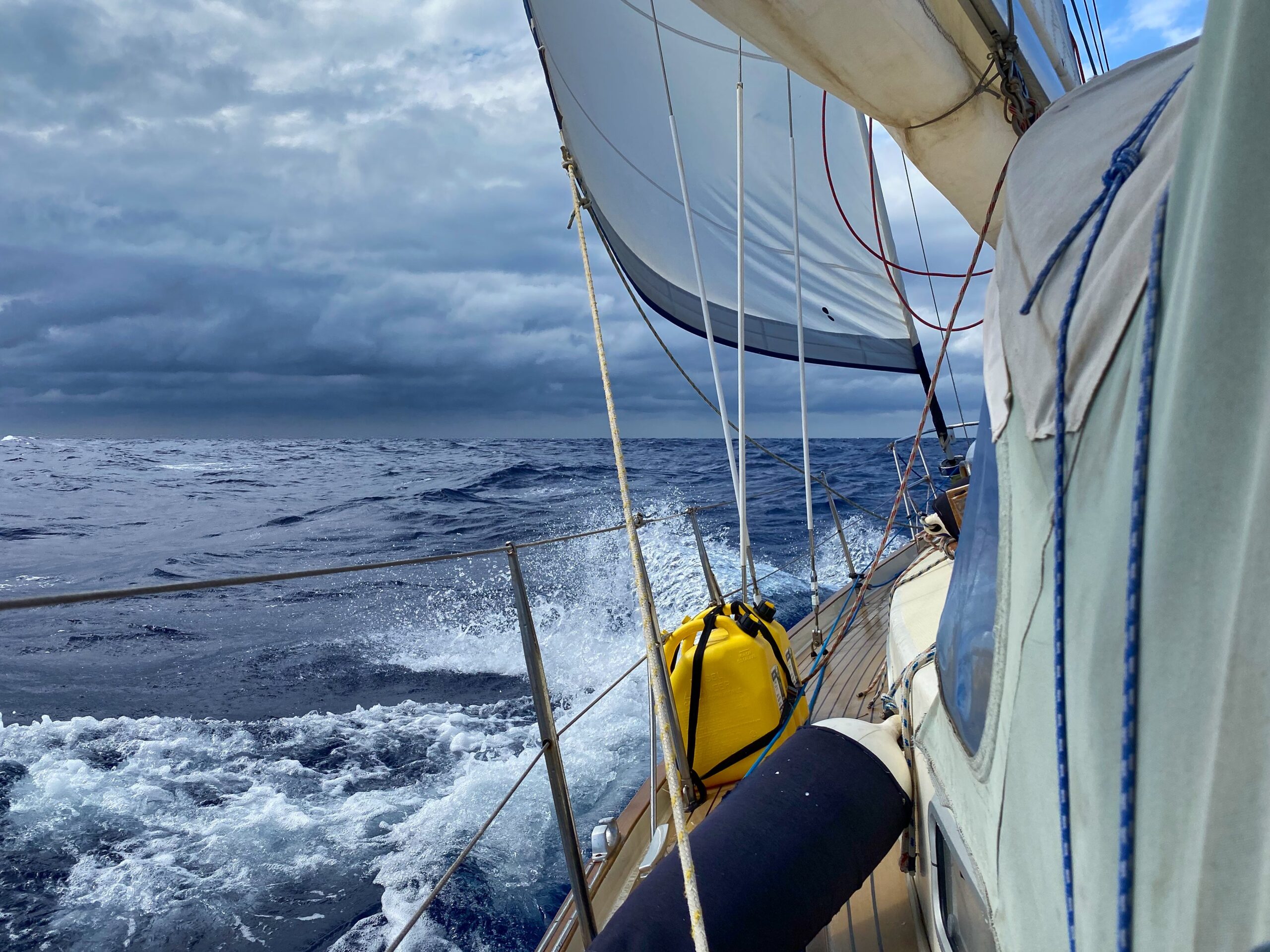
We will see in Santa Maria. Now we are in Horta. We started from Jolly Harbour too and we stayed at see 28 days. See you later . Marco and Federica on SeacaleII
Wow! What an amazing story! How brave you are!!! And skillful, of course! And I can’t wait to see you and Katrin in just a few days! Hope you have rested well! (Not that we’ll be partying!!) Jill xx
Thank you! Looking forward to seeing you here.
Awww that was just so so lovely to read. Thank you for sharing! We read this in the saloon of Caladh, our own victoria 34 with big dreams too! Very inspiring and beautifully written. We are in Cartagena at the moment, working our way to the Gib Strait. Maybe our wakes will cross one day, we do hope so. Fair winds. Kath & T xx
I follow you as well and enjoy your posts very much. I would be really happy to meet one day!